Swedish Masters in IT
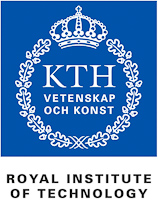 I think no one will dare to challenge the axiom that education is useful. Its benefits are particularly significant in the field of technical sciences. Each technician has his own way: some gain knowledge at the university, others prefer to study at work, gain practical skills and accumulate experience, others engage in self-education. At different times I tried different options and, ultimately, noted for myself that I like to study. The process of obtaining new knowledge gives me pleasure. As a drug addict reaches out to a new dose, so I reach out to new knowledge. And this thrust led to the fact that one morning I woke up as a student at a Swedish university. I looked around, got used to the new situation and I hasten to share my observations with Habr.
I think no one will dare to challenge the axiom that education is useful. Its benefits are particularly significant in the field of technical sciences. Each technician has his own way: some gain knowledge at the university, others prefer to study at work, gain practical skills and accumulate experience, others engage in self-education. At different times I tried different options and, ultimately, noted for myself that I like to study. The process of obtaining new knowledge gives me pleasure. As a drug addict reaches out to a new dose, so I reach out to new knowledge. And this thrust led to the fact that one morning I woke up as a student at a Swedish university. I looked around, got used to the new situation and I hasten to share my observations with Habr.So, the Royal Technological University of Sweden ( Kungliga Tekniska högskolan , KTH). Founded in the 19th century and is one of the leading technical universities in Scandinavia. In the world ranking is located at number 148 . Not a bad position, considering that my previous university occupied an honorable 2994 place. My master's program is called Communication systems . Various types of computer networks, mobile communications, network security and IT business are all included in the program. Training is completely in English.
Admission to KTH is a separate story. It was a year-long journey, and someday, perhaps, I will describe it separately. Now just note that the stage of entry may be completed in different ways. In the ideal case, the student will be given the opportunity to study for free, receive a monthly stipend and rent university housing for reasonable money.
University infrastructure and facilities
KTH includes several campuses within Stockholm, the main one being KTH Main Campus. The main campus looks impressive, recalling the old British universities in architectural style: massive red brick walls, cobbled road, ivy.
')

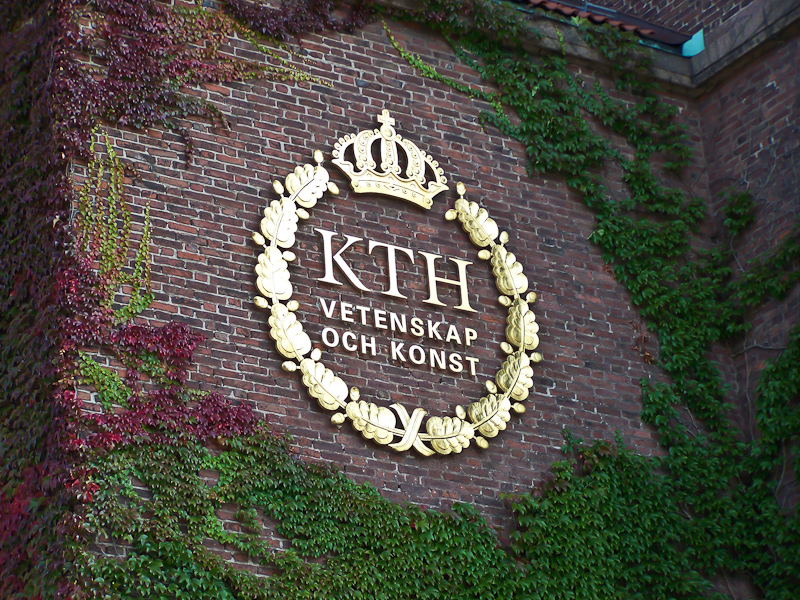
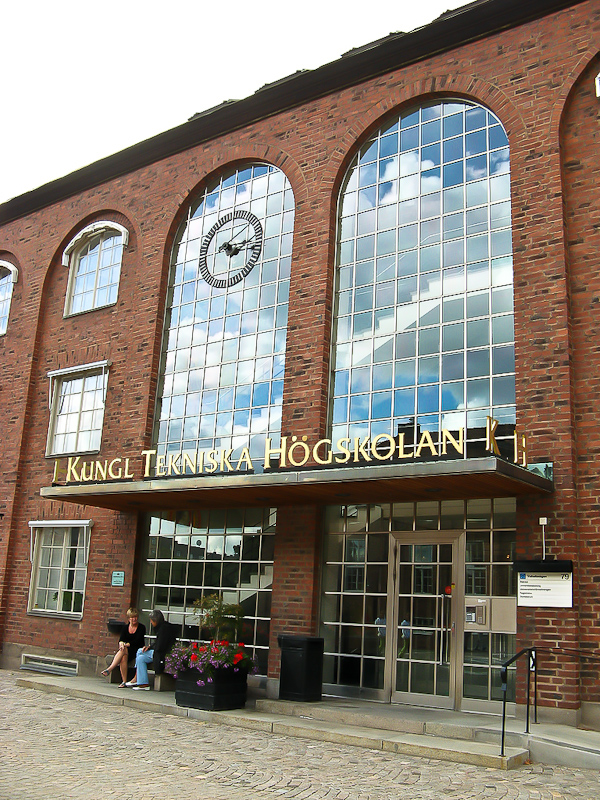
But IT-Schnick of this beauty is not observed, because they study for the most part not in the main campus, but in the north-western campus of Kista. Kista campus buildings are inherited from IBM by the university, so they are technologically advanced both inside and outside.

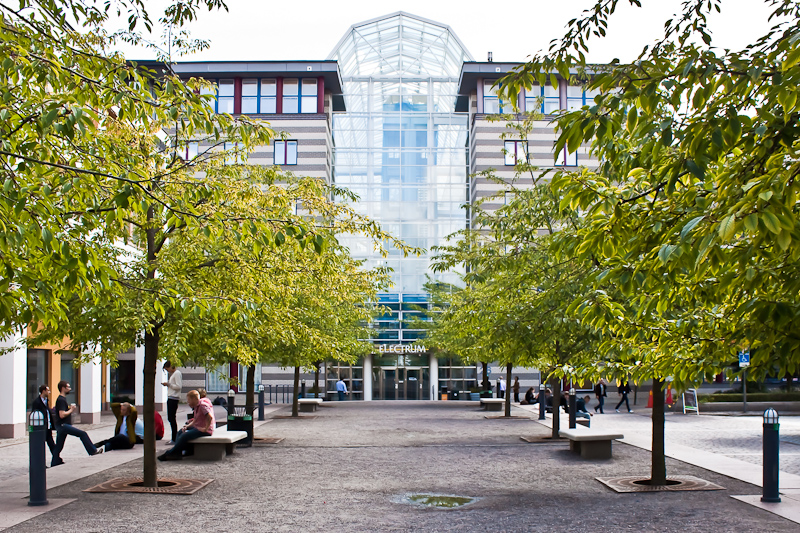
An electronic entry system has been deployed in campus buildings. I think in our time, and even more so in Sweden, by the presence of such a system you will not surprise anyone.


Each student has a magnetic card with a photo. The PIN is attached to the card.
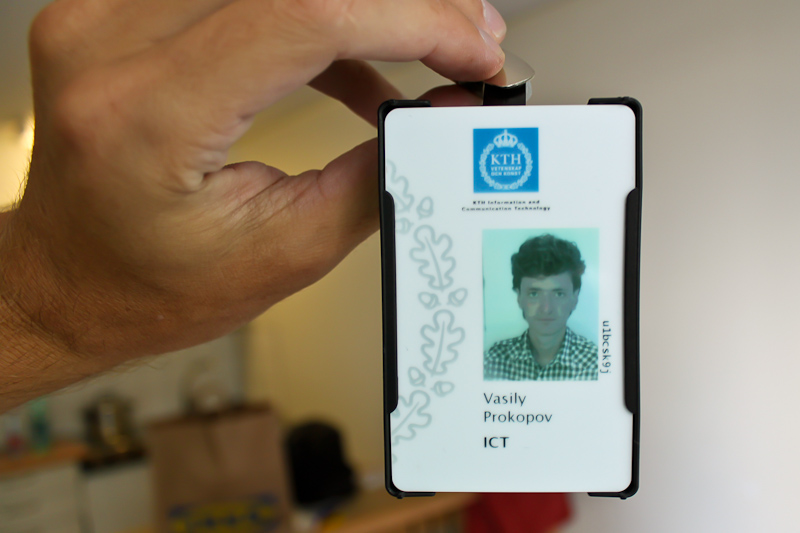
With this card and code, you can gain access to various rooms, such as computer labs, rooms with printers, or rooms for self-study. Students do not have free access to some parts of the building. But in this case, the telephone is always installed to contact the right person on the other side of the closed door.
Separately, I would like to note the care of the disabled. You can get into any point of the university building in a wheelchair thanks to ramps, elevators and wide doorways. One of our lecturers has problems with movement after an accident (pah-pah, a speedy recovery - a good uncle). So, he feels no limits and looks quite happy driving around the campus on his Segway.

The lecture halls are equipped with projectors and professional lighting equipment. There is also sound equipment, and if there are many listeners, the lecturer uses a wireless microphone.
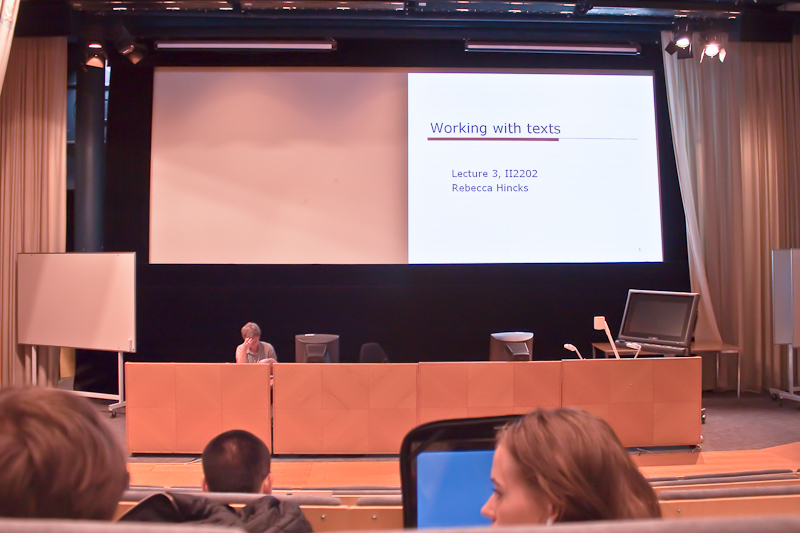

Interactive whiteboards are installed in the seminar rooms. They work like big monitors and react to touch.

In the premises for laboratory can meet a variety of equipment. In our program, we usually deal with network equipment Cisco, Juniper, HP. These devices are obtained by the university in the framework of partnership agreements with manufacturers. This, of course, is not about advanced lines. Nevertheless, the devices provide all the basic functionality, starting with support for dynamic routing protocols and ending with MPLS technology.

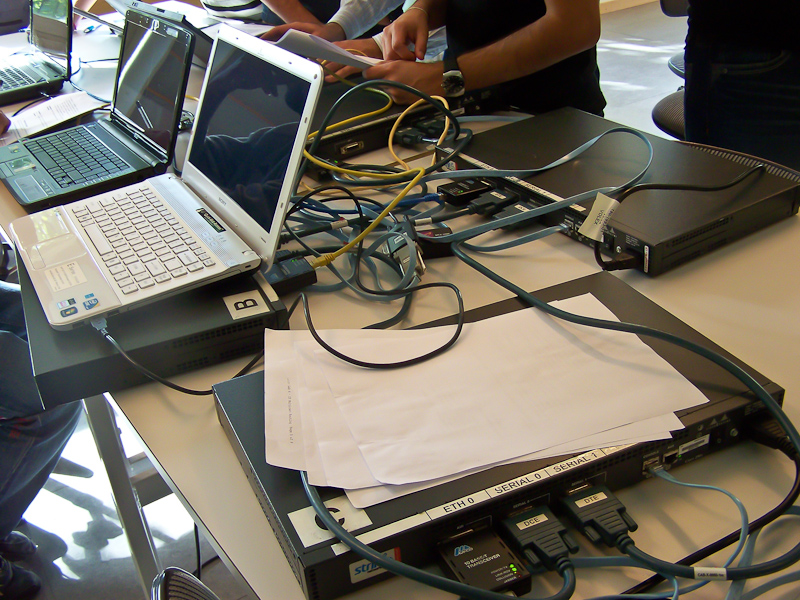
As for the rooms for self-study, then their great variety. They are located around the campus and are available almost around the clock. Nearby there is usually a kitchen with all the accompanying arsenal. Grab a snack right on the spot. Reservation is necessary through the university electronic system. If it was not possible to book a room in advance, which happens quite often, then you can stay in any corridor.

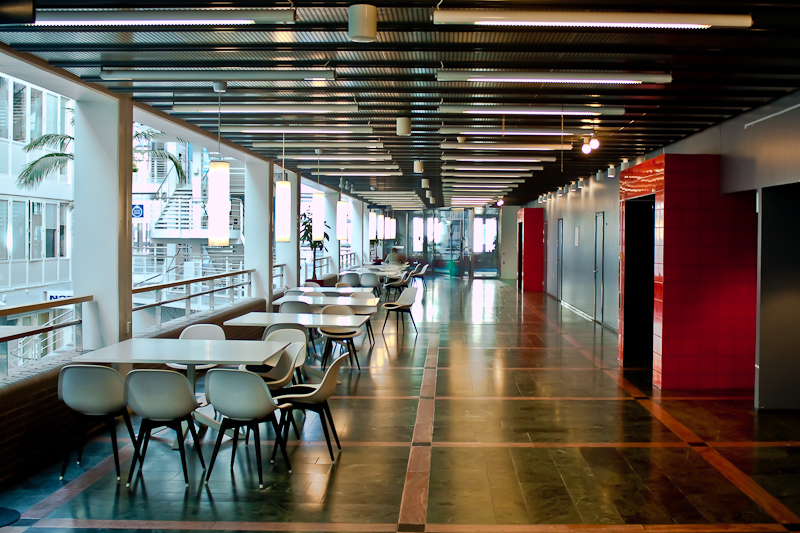
With a probability of 90 percent near the floor there is a power outlet and a jack for connecting to the university network. But you can do without wires: the entire campus is covered by a wireless Wi-Fi network with Internet access. With the network in general in Sweden, there are no problems. At home, students usually have 100 megabit channels with no traffic restrictions.
The university has a dining room. Here not only students, but also employees of the nearby offices of Ericsson and other IT-companies eat. Lunch, given the student discount, will cost 7 euros.


All these amenities are created with one goal - to make the student like to learn. However, one university infrastructure for this is not enough. The correct organization of the learning process itself is also important. Now I will tell you how it works with the Swedes.
Organization of educational process
The academic year is divided into 2 semesters - autumn and spring. Each semester, in turn, consists of 2 periods. Thus, we have 4 periods in an academic year. The first period starts at the end of August and ends with passing examinations in October. The second, third and fourth periods follow each other until the end of May. During each period a student studies a limited number of subjects (courses) - usually 2-3, not more. Courses can be chosen at your discretion. There are a number of required courses that you need to listen in any case. Differences from our education system are traced when we studied 5-8 subjects for half a year and closer to the end chaos began in an attempt to embrace the immense and pass all the exams.
In the western system it is easier - at the same time you focus on a limited number of subjects and have the opportunity to study them more deeply. In my opinion, the described system has the following advantages:
- Students do not fool around. Only 2 months are allotted for the course, so you need to work from the very beginning, otherwise you just don’t have time to cope with all the tasks
- Teachers have a finger on the pulse. Control points (exams, presentations, reports) are located tightly throughout the course.
- The student makes a decision on which courses to listen to every 2 months, which makes it possible to correct the trajectory of movement within the master's program. You study, for example, Wireless networks. I didn’t like it - in the next period I’m changing the track to Technology-based entrepreneurship.
What does the course consist of? If the course is technical, such as for example Advanced Internetworks, you will most likely have to deal with labs, a project and an exam. Lectures will also be, but usually their attendance is not mandatory, unlike laboratory and exam (who would doubt). However, most students attend lectures. The reason for this is bright, interesting and experienced teachers. Not all, of course. Sometimes it happens to have a “dead” lecturer. But even then the situation is not hopeless, because usually one person does not read all the lectures. It is common practice to invite so-called “guest” lecturers from other universities or people from industry. For example, Stina Ehrensvärd, the CEO of Yubico, which is engaged in multifactor authentication solutions, recently shared her entrepreneurial experience. Well, a certain Steve Ballmer looked in October.
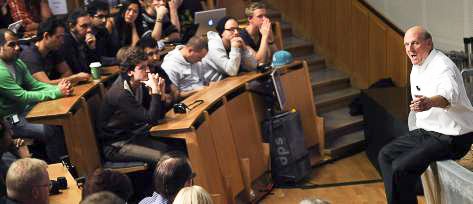
The winner of the Nobel Prize in Physics Konastantin Novoselov told us about graphene.
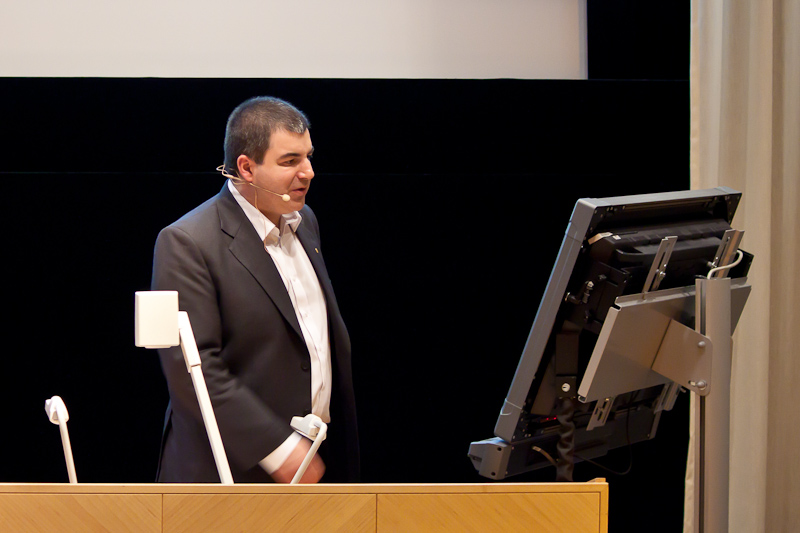
If we talk about good lecturers, then first of all I will note American professors. There are a lot of them at KTH and they make presentations from their lectures. I remember most of all the professor who worked most of his career at HP Labs in America. He is very exciting and with a huge number of examples from personal practice told about the stages of creating an IT product. It was also interesting to learn firsthand how some time ago, the HP team dismantled the Palm PDA screw in order to identify the components and understand why their competitors jumped around. Reverse engineering performed by HP.
In addition to lectures, almost every course involves a small project performed by a group of students from 3 to 15 people. The team includes people belonging to different cultures. Not everyone has the skills of group work and technical experience. For these reasons, working with them is often not easy. According to my observations, the role of leaders in the team is more often assumed by Europeans. Asians prefer to perform specific tasks set by the leaders. Teamwork is always difficult, but ultimately has a positive effect in the form of new acquaintances and experience.
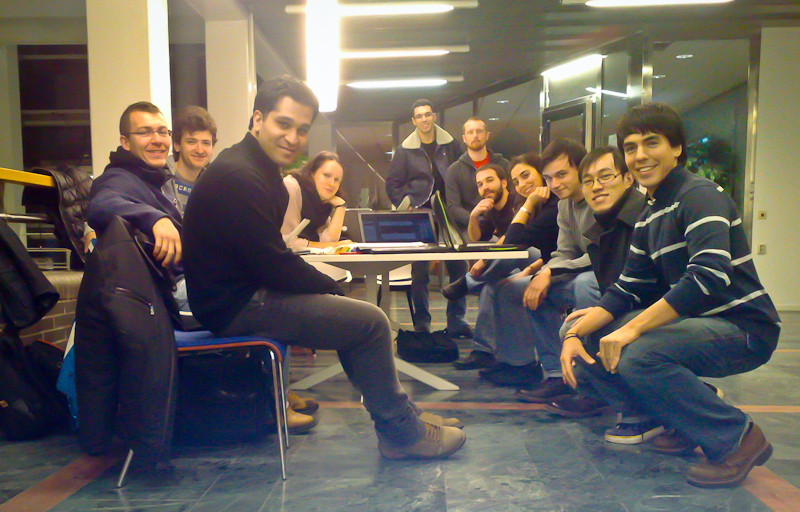

The task of the most interesting project in my practice was to develop an IT product that recognizes a person’s emotions. In 2 months it was necessary to go from the idea to the working prototype. Students were offered various options: from the chain around the neck, able to assess the emotional state of a person and in accordance with this update his status on Facebook, to a device monitoring the emotional state of a child and warning parents in case of danger. Our team presented the prototype of the latter at the final presentation. Here is what he looked like:
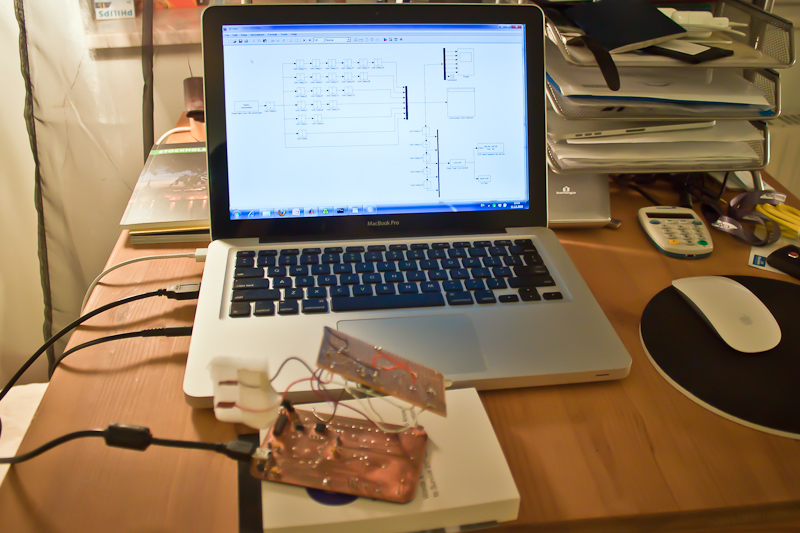
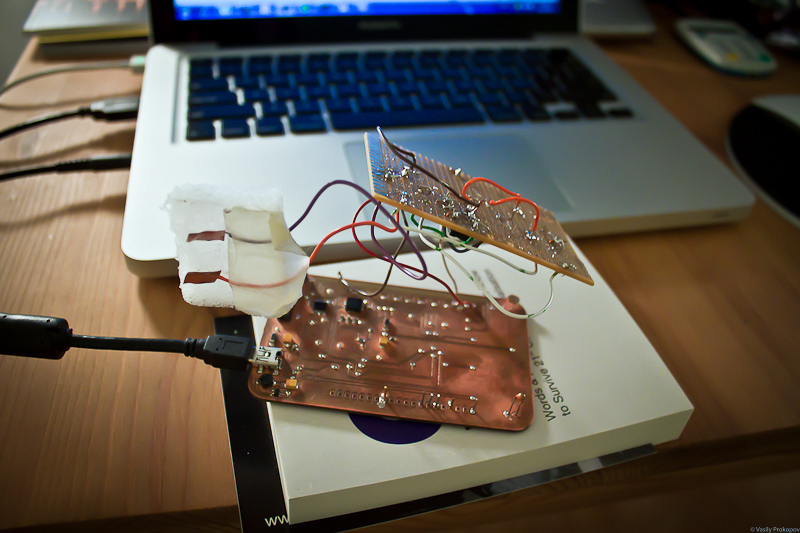
The team is in the process of working on this technical masterpiece.
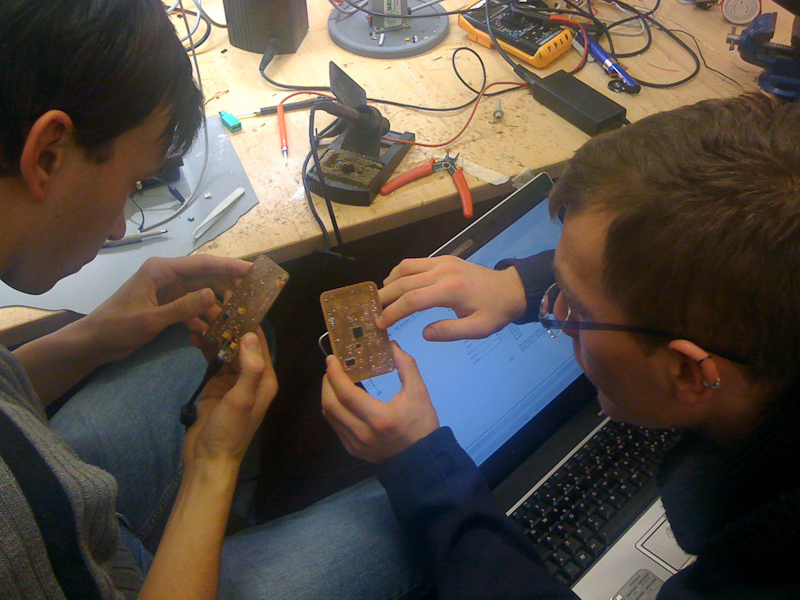
Further, what are the laboratory? In this part, the difference from our universities is minimal. Usually it all comes down to setting up the equipment in a small network topology. For example, a task requires configuring MPLS including Traffic Engineering on Juniper devices. For admission to the lab is required to pass an online test of a dozen questions. It is not necessary to write a report, it is enough to support the conversation with the teacher and answer his questions in the course of the laboratory.
Come to the most interesting - the exam. It lasts 4 hours. The electronic system randomly selects an audience and a place in this audience for each student. There is practically no chance to sit next to the excellent student Liao and write off everything. Yes, and it is dangerous to write off: KTH adopted a policy of "zero tolerance" for deceivers. Near each exam room there is a list with the names of students.


Telephones and personal belongings are usually put in a certain place. With a table you can take only a pen or pencil. For your creations will be given a special paper with a coat of arms, it is allowed to write only on it. The exam itself usually consists of two parts (it is now a technical exam). The first part proposes to choose the right answers to a series of short questions. If in this part the student does not score the minimum required number of points, for example, 15 out of 20, then the exam is failed. The second part in this case does not even look. If the student overcame the threshold in the first part, then evaluate the second part, which usually consists of 3-5 more difficult questions in comparison with the first part. Answer the questions of the second part must be deployed, the answers are not offered here. The sum of points scored in both parts determines the grade. Here is an example of my test assignment for the course “Internet security and privacy”.
During the exam, the instructors responsible for the course come into the classroom several times and answer questions raised by students. An “overseer” is constantly present in the audience, but he usually has nothing to do with the course. If something is not clear in the task, it does not make sense to ask about this “overseer”.
Sometimes due to some circumstances (usually not dependent on the student;) it is not possible to go all the way competently and the student floods the lab, the project or the exam. In this case, the only way out is to pack a suitcase and go back home ... Just kidding, you can always correct the situation. The rules are very liberal:
- Not done the lab? It does not matter, at the end of the period there is one additional “make-up” session, within which you can perform any of the missed labs. But only once, and only once. If there are more debts on the labs - the train is gone, the course will not be counted.
- Failed the exam? Trivia, at the end of the semester time is allotted for retake.
- Got a low score and think you deserve more? Again, welcome to retake. You can try at least every time you read a course (usually once a year). Ultimately, the best of the estimates obtained will go to the diploma.

Most of all I like the non-linearity of the AF rating scale. Low scores are easy to get, while as you move to A, candidate requirements increase exponentially. Therefore, an excellent student here is not easy. At the highest level there will be a truly outstanding mind, while at home, both a genius and just a stupid lucky person could become an excellent student.
On this, perhaps, I will draw the line.
The description touched only the academic part of my life in Sweden. I tried to save the text in the Habr format, so my friends and parties were left behind the brackets.
Source: https://habr.com/ru/post/114858/
All Articles